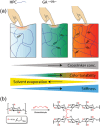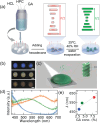Spatiotemporal Retention of Structural Color and Induced Stiffening in Crosslinked Hydroxypropyl Cellulose Beads
- PMID: 39648318
- PMCID: PMC11884224
- DOI: 10.1002/marc.202400755
Spatiotemporal Retention of Structural Color and Induced Stiffening in Crosslinked Hydroxypropyl Cellulose Beads
Abstract
Hydroxypropyl cellulose (HPC) is known for its ability to form cholesteric liquid crystalline phases displaying vivid structural colors. However, these vibrant colors tend to fade over time when the material dries. This issue is a major bottleneck to finding practical applications for these materials. Here this problem is overcome by producing free-standing, millimeter-sized HPC structurally colored beads with spatiotemporal color retention, facilitated by a glutaraldehyde crosslinker. By leveraging the well-known chemically induced stabilization of cholesteric liquid crystalline phases, stable structural colors are achieved for at least three weeks. The presence of glutaraldehyde significantly increases the mechanical stiffness, with Young's modulus rising from 0.3± 0.1 GPa to 1.8± 0.2 GPa. This integrated approach of creating free-standing photonic HPC beads offers a strategy for developing robust and durable photonic HPC materials with enhanced stability, advancing photonic material applications with spatiotemporal color stability.
Keywords: Young's modulus; chiral nematic; crosslinker; hydroxypropyl cellulose; self‐assembly; structural colors.
© 2024 The Author(s). Macromolecular Rapid Communications published by Wiley‐VCH GmbH.
Conflict of interest statement
The authors declare no conflict of interest.
Figures





References
-
- Arca H. C., Mosquera‐Giraldo L. I., Bi V., Xu D., Taylor L. S., Edgar K. J., Biomacromolecules 2018, 19, 2351. - PubMed
-
- Guo J.‐H., Skinner G. W., Harcum W. W., Barnum P. E., Pharmaceutical Science & Technology Today 1998, 1, 254.
-
- Martin‐Pastor M., Stoyanov E., J. Polym. Science 2021, 59, 1855.
-
- Park H. J., Chinnan M. S., J. Food Eng. 1995, 25, 497.
-
- Park H. J., Weller C. L., Vergano P. J., Testin R. F., J. Food Sci. 1993, 58, 1361.
MeSH terms
Substances
Grants and funding
LinkOut - more resources
Full Text Sources

